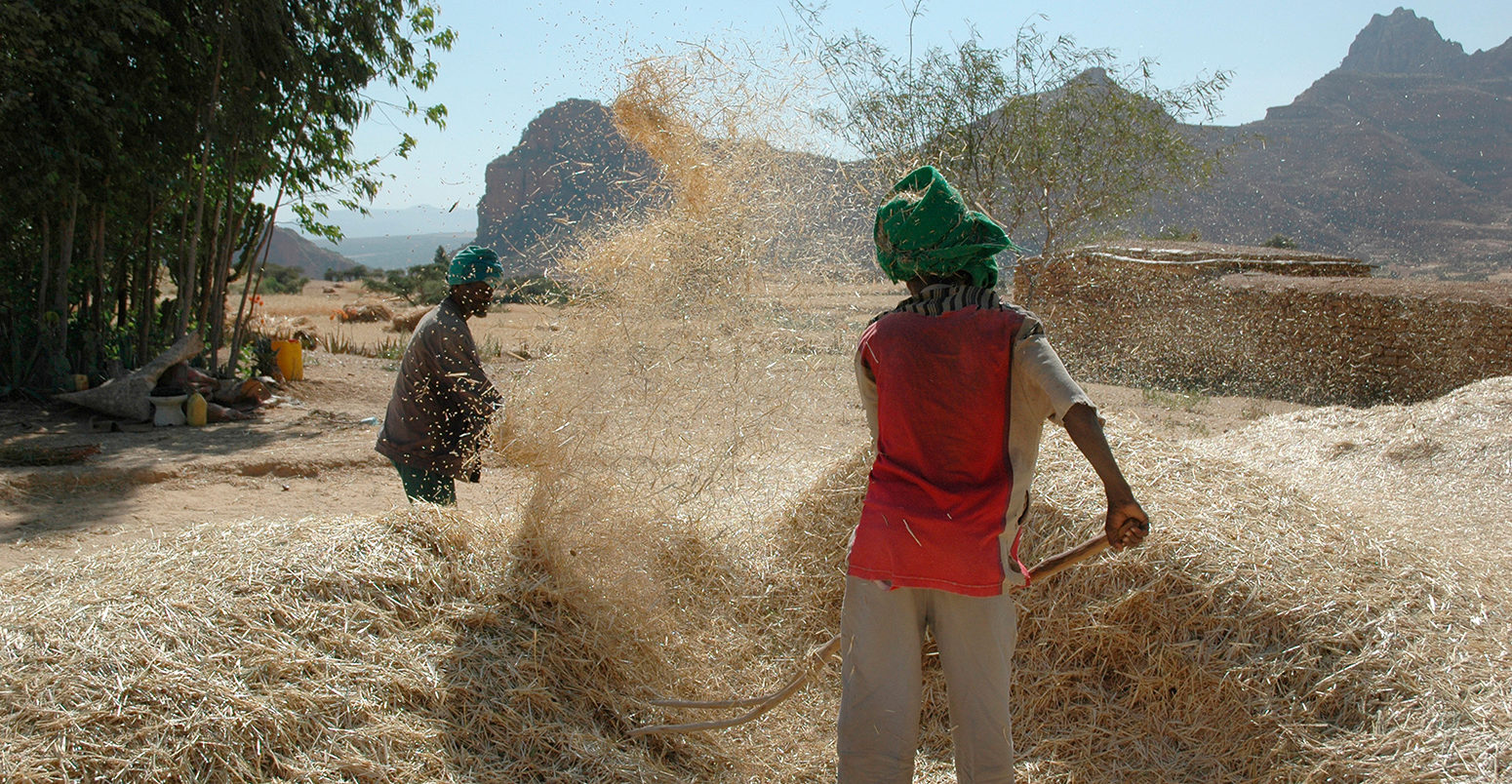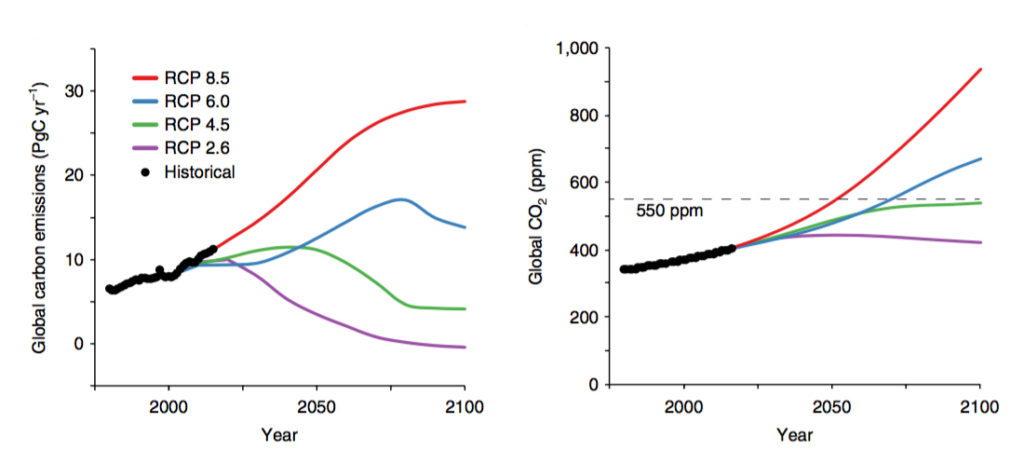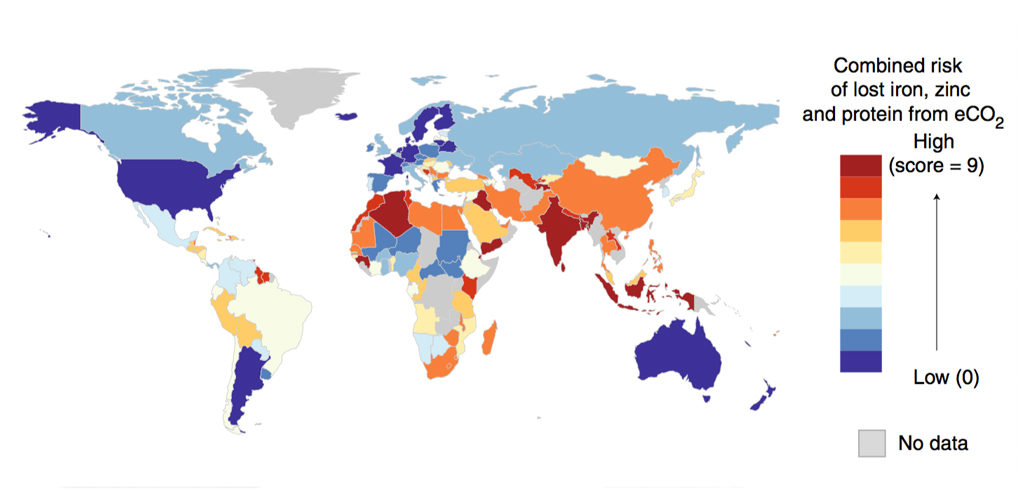
Rising CO2 levels could push ‘hundreds of millions’ into malnutrition by 2050
Daisy Dunne
08.27.18Daisy Dunne
27.08.2018 | 4:00pmAn additional 290 million people could face malnutrition by 2050 if little is done to stop the rise of greenhouse gas emissions, a study finds.
The increased presence of CO2 in the atmosphere could cause staple crops to produce smaller amounts of nutrients such as zinc, iron and protein, the researchers say.
Using international datasets of food consumption, the study estimates that these changes could cause an additional 175 million people to be zinc deficient and an additional 122 million people to be protein deficient by 2050.
The findings show that malnutrition is most likely to affect parts of the world that are already grappling with food insecurity, such as India, parts of North Africa and the Middle East, the lead author tells Carbon Brief.
Growing problems
Climate change is known to threaten food security by increasing the chances of extreme weather events such as heatwaves and drought – which can cause crop failures.
However, climate change could also threaten food security by worsening malnutrition.
Across the world, humans get the majority of the key nutrients they need from plants. Crops, including cereals, grains and beans, provide humans with 63% of their protein, which is needed to build new body tissue.
Plants also provide humans with 81% of their iron, a nutrient that facilitates the flow of blood around the body, and 63% of their zinc, a nutrient that helps fight off disease. (Other sources of these nutrients include meat and dairy.)
However, recent experiments show that, when food crops are exposed to high levels of CO2, they tend to produce lower amounts of these three key nutrients.
The reason why this happens is still not well understood, says Dr Matthew Smith, a researcher in environmental health from Harvard University and lead author of the new study published in Nature Climate Change. He tells Carbon Brief:
“The prevailing theory for many years has been that higher CO2 causes a faster growth rate [in crops] – which favours carbohydrates rather than other nutrients important for human health that cannot be taken up quickly enough by the roots.”
However, there is also evidence that suggests not all nutrients decrease under higher CO2, notes Smith, meaning the extent of the impact is still an “open question”.
Under pressure
For the new study, the researchers estimated how global levels of malnutrition would be affected when the average concentration of CO2 in the atmosphere reaches 550 parts per million (ppm).
Earlier experiments by the research group have shown that, at this concentration, the iron, protein and zinc content of food crops such as rice, wheat and maize can fall by 3-17%.
Levels of CO2 are currently around 409ppm – and are expected to reach 550ppm in the next 30 to 80 years, depending on how quickly greenhouse gases are – or are not – curbed.
The charts below show the expected carbon emissions (left) and point at which 550ppm is reached (right) for a range of future socioeconomic scenarios known as the “Representative Concentration Pathways” (RCPs). Historical data is also shown in black.

Left: Global carbon emissions (black) and projected emissions under RCP2.6 (purple), RCP4.5 (green), RCP6.0 (blue) and RCP8.5 (red) from 1980-2100. Right: Global CO2 ppm from 1980-2100, with dashed line indicating point at reach concentrations reach 550ppm. Source: Smith & Myers (2018)
The charts show how, under a high or “business as usual” scenario (“RCP8.5”), CO2 levels will reach 550ppm by 2050. However, if warming is limited to no more than 2C (“RCP2.6”), the world could avoid hitting the milestone altogether.
For their calculations, the researchers assume that the world follows a “business as usual scenario” and 550ppm is reached by 2050.
To understand how hitting 550ppm could impact malnutrition, the researchers made projections using datasets on food consumption taken from countries across the world.
The datasets contained information on what types of crops are eaten in different parts of the world. In earlier experiments, the researchers found that “C3 crops” (so called because, during photosynthesis, they produce a sugar that has three carbon molecules) are most likely to be affected by rising CO2 levels. Common C3 crops include potatoes, wheat and rice.
![]()
The results show that, based on estimated population levels for 2050, an additional 175 million people – or 1.9% of the global population in 2050 – could become deficient in zinc and an additional 122 million people (1.3% of the global population) could become protein deficient as CO2 levels exceed 550ppm.
The researchers were not able to estimate the number of additional people that could face iron deficiencies. However, they did find that, by 2050, nearly 1.4 billion women and children under five could live in regions deemed at high risk of iron deficiencies.
At present, more than two billion people are estimated to be deficient in one or more of these nutrients. If crops become less nutritious, these people are likely to face more severe deficiencies, the researchers say, with serious impacts for their health.
Severe iron deficiency, for example, is associated with anemia, a condition where the body lacks enough red blood cells to carry adequate oxygen to body tissue. The condition causes weakness and tiredness and, in extreme cases, can affect the heart and lungs.
Severe zinc deficiency can be fatal if left untreated, while severe protein deficiency can lead to kwashiorkor – a condition causing swelling under the skin that can also be fatal.
Diet distributions
To explore how malnutrition is likely to be distributed across the world, the researchers gave each country a ranking of between one and three for each nutrient – with one indicating a small increase in deficiency and three indicating a large increase.
They then added the results together to give each country a score out of nine. The results are shown on the map below, where dark blue indicates a low score (zero) and dark red indicates a high score (nine).

Global combined risk of lost iron, zinc and protein, assuming average concentrations of CO2 reach 550ppm by 2050. Dark blue indicates a low score (zero), dark red indicates a high score (nine) and indicates no data. Source: Smith & Myers (2018)
The results show that India faces the largest malnutrition increases out of any country. By 2050, an additional 50 million people in India could become zinc deficient, while an additional 502 million women and children under five could face anemia as a result of iron deficiencies.
Other high-risk countries include Algeria, Iraq and Yemen – three countries which are already grappling with higher-than-average rates of malnutrition, Smith says:
“Hundreds of millions of people could become newly deficient in these nutrients – primarily in Africa, southeast Asia, India and the Middle East – potentially contributing to a range of health effects: anemia, wasting, stunting, susceptibility to infectious disease, and complications for mothers and newborns.”
Curbing CO2
Despite the stark findings, there are “many steps that can be taken” to reduce the impact of rising CO2 levels on malnutrition, Smith says:
“Breeding crops for CO2-tolerance or higher nutritional content, increasing [iron] fortification or supplementation programmes, encouraging dietary diversity to include more nutrient dense foods or those less sensitive to CO2 effects, for example. And of course, renewing our global effort to curb CO2 emissions would be the most direct way to help avert potential harm.”
One caveat of the new research is the assumption that current patterns of global food consumption are likely to stay the same until 2050, Smith says:
“We definitely agree that it is highly unlikely that diets will stay static, but we make this assumption simply because we are unsure of which direction diets will go. Dietary forecasting is very uncertain, and it relies primarily on economic projections to determine how diets will change.”
Previous research suggests that low- to middle-income countries are likely to consume more meat and dairy products in the coming decades. If this were to occur, the impact of rising CO2 levels on crops – and thus malnutrition – could be smaller, Smith concedes.
The findings add to previous research showing “the potential health consequences” of rising CO2 levels, says Prof Kristie Ebi, a researcher in public health and climate change from the University of Washington, who was not involved in the study. She tells Carbon Brief:
“The growing body of literature on the impacts of rising CO2 concentrations on the nutritional quality of our food indicates the health consequences could be significant, particularly for poorer populations in Africa and Asia – although everyone could be affected.”
Smith, M. R. and Myers, S. S. (2018) Impact of anthropogenic CO2 emissions on global human nutrition, Nature Climate Change, doi:10.1038/s41558-018-0253-3
-
Rising CO2 levels could push ‘hundreds of millions’ into malnutrition by 2050
-
Malnutrition to blight ‘India, North Africa and the Middle East’ as CO2 levels rise

